
Fucus vesiculosus, known by the common names bladderwrack, black tang, rockweed, sea grapes, bladder fucus, sea oak, cut weed, dyers fucus, red fucus and rock wrack, is a seaweed found on the coasts of the North Sea, the western Baltic Sea and the Atlantic and Pacific Oceans. It was the original source of iodine, discovered in 1811, and was used extensively to treat goitre, a swelling of the thyroid gland related to iodine deficiency.

Nereocystis is a monotypic genus of subtidal kelp containing the species Nereocystis luetkeana. Some English names include edible kelp, bull kelp, bullwhip kelp, ribbon kelp, bladder wrack, and variations of these names. Due to the English name, bull kelp can be confused with southern bull kelps, which are found in the Southern Hemisphere. Nereocystis luetkeana forms thick beds on subtidal rocks, and is an important part of kelp forests.

Fucus is a genus of brown algae found in the intertidal zones of rocky seashores almost throughout the world.
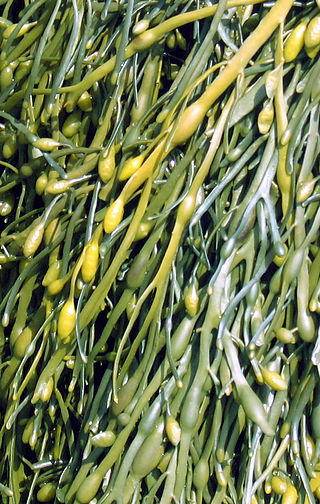
Ascophyllum nodosum is a large, common cold water seaweed or brown alga (Phaeophyceae) in the family Fucaceae. Its common names include knotted wrack, egg wrack, feamainn bhuí, rockweed, knotted kelp and Norwegian kelp. It grows only in the northern Atlantic Ocean, along the north-western coast of Europe including east Greenland and the north-eastern coast of North America. Its range further south of these latitudes is limited by warmer ocean waters. It dominates the intertidal zone. Ascophyllum nodosum has been used numerous times in scientific research and has even been found to benefit humans through consumption.

Alaria esculenta is an edible seaweed, also known as dabberlocks or badderlocks, or winged kelp, and occasionally as Atlantic Wakame. It is a traditional food along the coasts of the far north Atlantic Ocean. It may be eaten fresh or cooked in Greenland, Iceland, Scotland and Ireland. It is the only one of twelve species of Alaria to occur in both Ireland and in Great Britain.

Fucus serratus is a seaweed of the north Atlantic Ocean, known as toothed wrack, serrated wrack, or saw rack.
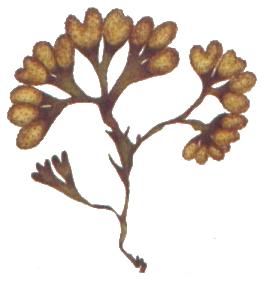
Fucus spiralis is a species of seaweed, a brown alga, living on the littoral shore of the Atlantic coasts of Europe and North America. It has the common names of spiral wrack and flat wrack.
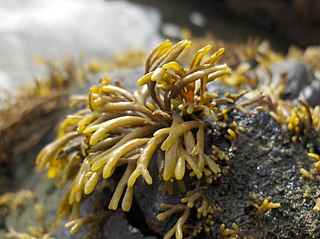
Pelvetia canaliculata, the channelled wrack, is a very common brown alga (Phaeophyceae) found on the rocks of the upper shores of Europe. It is the only species remaining in the monotypic genus Pelvetia. In 1999, the other members of this genus were reclassified as Silvetia due to differences of oogonium structure and of nucleic acid sequences of the rDNA.

Wrack is part of the common names of several species of seaweed in the family Fucaceae. It may also refer more generally to any seaweeds or seagrasses that wash up on beaches and may accumulate in the wrack zone.

Padina pavonica, commonly known as the peacock's tail, is a small brown alga found in the Indian Ocean, the Pacific Ocean, the Atlantic Ocean and the Mediterranean Sea. It inhabits pools in the littoral zone typically with clayey, silty or sandy sediments. Other habitats include rocks and shell fragments in the shallow sublittoral, seagrass meadows, mangrove roots and coral reefs on tidal flats.

The Ballantine scale is a biologically defined scale for measuring the degree of exposure level of wave action on a rocky shore. Devised in 1961 by W. J. Ballantine, then at the zoology department of Queen Mary College, London, the scale is based on the observation that where shoreline species are concerned "Different species growing on rocky shores require different degrees of protection from certain aspects of the physical environment, of which wave action is often the most important." The species present in the littoral zone therefore indicate the degree of the shore's exposure.
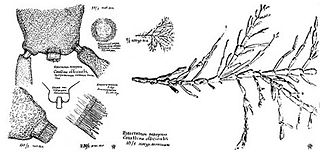
Corallina officinalis is a calcareous red seaweed which grows in the lower and mid-littoral zones on rocky shores.
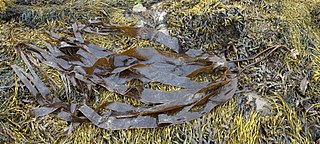
Laminaria digitata is a large brown alga in the family Laminariaceae, also known by the common name oarweed. It is found in the sublittoral zone of the northern Atlantic Ocean.
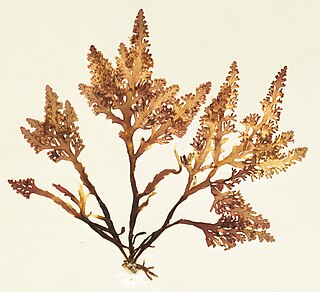
Osmundea pinnatifida is a species of red alga known by the common name pepper dulse.

Fucus distichus or rockweed is a species of brown alga in the family Fucaceae to be found in the intertidal zones of rocky seashores in the Northern Hemisphere, mostly in rock pools.
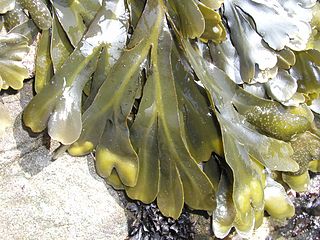
Fucus gardneri is a species of seaweed, a brown alga living on the littoral shore of the Pacific coasts of North America. It has the common names of rockweed and bladderwrack.
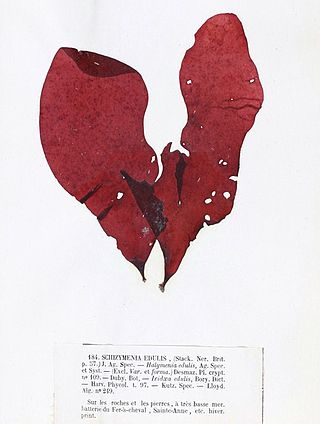
Dilsea carnosa, commonly known as the poor man's weather glass or the sea belt, is a species of red algae in the Dumontiaceae family of the order Gigartinales.

Fucus radicans is a species of brown algae in the family Fucaceae, endemic to and recently evolved within the Baltic Sea. The species was first described by Lena Bergström and Lena Kautsky in 2005 from a location in Ångermanland, Sweden. The specific epithet is from the Latin and means "rooting", referring to the fact that this species primarily reproduces by the taking root of detached fragments.
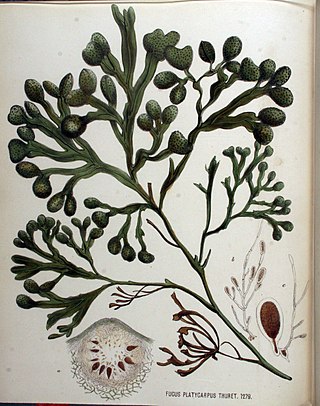
Fucus guiryi is a brown alga in the family Fucaceae. It is known from numerous locations along the east coast of the North Atlantic Ocean, from Ireland to the Canary Islands.

Polysiphonia lanosa is a common species of the red algae (Rhodophyta) often to be found growing on Ascophyllum nodosum.


















